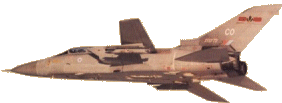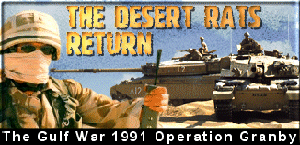Desert Shield: The Air War

Within seven days of the UN resolution on the Iraqi invasion of Kuwait the British government announced the deployment of a squadron each of Tornado F.Mk 3 and Jaguar GR.Mk 1A aircraft to the region. Tristars flew in ground support and administrative personnel while VC10 tankers refuelled aircraft. The Tornado F.Mk 3s were quickly tasked with Combat Air Patrols flying alongside their USAF and Saudi counterparts. To provide naval support three Nimrod maritime patrol aircraft were deployed to Seeb, Oman and a detachment of Tornado GR.Mk 1s made for Bahrain. In the following month, GR.MK1 As followed to provide tactical reconnaissance and another GR.Mk 1 squadron joined them before the start of desert Storm. The RAFs offensive forces now had 50 Tornadoes and 12 Jaguars on Strength.

Tornado GR1
Transport and logistics were supplied by a detachment of Hercules, Tristar and VC10 C.Mk1s. A further five Hercules were based in the United Arab Emirates for undercover operations. More tankers, this Time Victor K.Mk.2s began arriving at bahrain, 6 were in place on the 16th January. After desert Storm began, a dozen veteran Buccaneer S.Mk 2Bs equipped with Pave Spike laser-designators and two Tornados with TIALD pods also arrived. Helicopters in the Gulf were from all three services, but RAF aircraft involved Sea kings and 15 Puma HC.Mk1s transported to the theatre by USAF C-5 Galaxys and three Chinook HC.Mk 1Bs. Some of the other Chinooks to arrive in theatre were assigned to Special operations Duties. These Chinooks delivered British and American Special Forces teams into Iraq and kuwait and it was a Chinook that delivered the SBS team which retook the British Embassy in Kuwait city. The Helicopters on the Ground were backed up by Naval Lynx HAS.Mk 3 armed with Sea Skua missiles which would claim several small vessel kills from the Iraqi navy, while its Army counterpart the Lynx AH..Mk 7 and Gazelles AH.Mk 1 claimed a reputable number of enemy armoured vehicles in the air war.
On the eve of the opening of Desert Storm, The British Forces were present at the following airfields:
RAF Akrotiri, Cyprus
Nimrod R.Mk 1
Tabuk, AB, Saudi Arabia
Tornado GR.Mk 1
Seeb, Oman
Nimrod MR.Mk 2 Nimrod R.Mk 1
King Khalid Military City (Operating with ground forces)
Army Air Corps Gazelle AH.MK 1
Army Air Corps Lynx AH.Mk 7
Bahrain International Airport, Muharraq
Tornado GR.Mk 1
Jaguar GR.Mk 1A
Dhahran RSAF AB
Tornado F.Mk 3
Tornado GR.Mk 1
Operation Desert Storm

When Desert Storm opened on 16th January 1991, The first air missions were totally air-defence suppression, once the air defences were smashed the RAF Tornado GR.Mk1 smashed the Iraqi airfields from low-level with Hunting JP223 runway denial systems. This was undoubtedly the most dangerous of all missions, with the Tornadoes suffering the highest loss to mission ratio and these aircraft were withdrawn form this mission shortly after to converse aircraft and their crews once the primary airfield smashing had been accomplished. RAF Tornadoes did participate in air-defence suppression missions once the Alarm missile arrived in theatre, having been rushed through the approval process and into action. No Air-to-Air kills were made by the RAF, all being taken by the more numerous and capable USAF Eagles and two by a Saudi Eagle.
Once the airfields had been smashed, the Iraqi military started launching its Scud missiles at its neighbors this necessitated the RAF crews and their helicopters and ground counterparts working in NBC gear at some times, dirty, dangerous and hot work. The RAF Tornadoes joined th American aircraft in hunting down the mobile Scud launchers in the vast deserts of Iraq. When the 100-hour ground war started, everything went into the smashing of the remaining Iraqi ground forces and their fleeing transports.
With the Iraqis' driven out of kuwait the Gulf War came to an end, and the Coalition air forces settled down to enforcing the Un resolutions imposed on the Iraqis' and in particular the No-fly Zones. This duty would continue for more than seven years. The British lost 10 Tornado Gr.Mk 1s in the Gulf War, Six to Surface to Air Missiles, Two to Anti-Aircraft Artillery and The loss of the tenth remains unknown.



